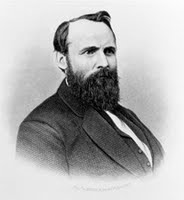"The Happiest Moments of His Life"

Col. Ozora Pierson Stearns (1831-1896) of the Thirty-ninth U.S. Colored Infantry, in an interview with an historian, recounted his participation in the ill-fated Battle of the Crater along the front lines at Petersburg, Virginia, on July 30, 1864. In this excerpt, Stearns' graphic account of the battle caught my attention:
At the mine explosion in front of Petersburg July 30, Colonel Stearns’ regiment was the last to go into the fight after the rebels had rallied and formed a cordon of fire along the whole front. As they were passing the crater, moving by the flank, a cannon-ball took off the head of one of his men near the front of his regiment, and threw the head of the column into some confusion. The air was full of grape canister-shells and minie-balls. The colonel mounted a chunk of clay about three feet high, and drew his sword and shouted to his regiment with a voice that could be heard above the din of the battle, and it immediately came into line and filed past him in excellent order. Those were, he declares, the happiest moments of his life.The last sentence brought to mind Gen. Robert E. Lee's often repeated quote, "It is well that war is so terrible — lest we should grow too fond of it." I suspect that Stearns, who went on to become a respected judge, serve a stint as U.S. Senator, and become a staunch supporter of women's suffrage, would not have ever wanted to be in such a position of danger again. And yet, it is clear that in that moment at the edge of the Crater, as he stood atop a boulder with a commanding view of the utter chaos unfolding around him in contrast to the orderly procession of his men, he experienced two extreme emotions almost simultaneously, the thrill of victory and the agony of defeat.
How you or I would react to such battlefield stress is an unknown. Would we feel elated, as Stearns recalled in later years, or would we be forever damaged by the experience? Or both?
Stearns' recollection of the Battle of the Crater continues:
When the rebels made their final charge, after nearly the whole line had given way, Colonel Stearns rallied a few men and was holding a short piece of the line just at the right of the crater, when a shell burst, seemingly right in his face, which stunned him for a moment. When he recovered he was alone — all others had fallen or fled. There were some still fighting in the crater. He went into it to see what could be done. He saw it was impossible to hold it. This was just after the Forest massacre. He thought, if captured, he would be hung. He concluded to try and reach the Union lines, one hundred and fifty yards away. As he started, several started with him. They had gone but a few yards when every man that started with him had fallen. In his mind he gave up all hope and said: “Well, you’ve got me now, and you’ll shoot me in the back, but you shan’t shoot me running.” He then stopped running, took out his sword and walked slowly, clipping weeds. He reached the old line of works, leaped over them, and commenced preparing for an expected assault on that line. Just then another shell burst, seemingly in his face. Against his right shoulder was a cavalry soldier and against his left a colored soldier. The shell tore off the shoulder of the cavalry soldier so he could see the beating of his lung, and tore away the chin of the colored soldier. The colonel was unharmed. He lost in this engagement ten officers and one hundred and eighty-five men killed and wounded. His colors had thirteen ball holes through them. His color-bearer, at his request, was voted by congress a medal of honor for bravery in the battle.— Butterfield, Consul Willshire. “Bench and Bar of Duluth.” Magazine of Western History (March 1889). Photo from Wikipedia.
Labels: 39th, battle, civil war, colonel, crater, history, military, ozora pierson stearns, petersburg, thirty-ninth, u.s. colored infantry, union, usct

